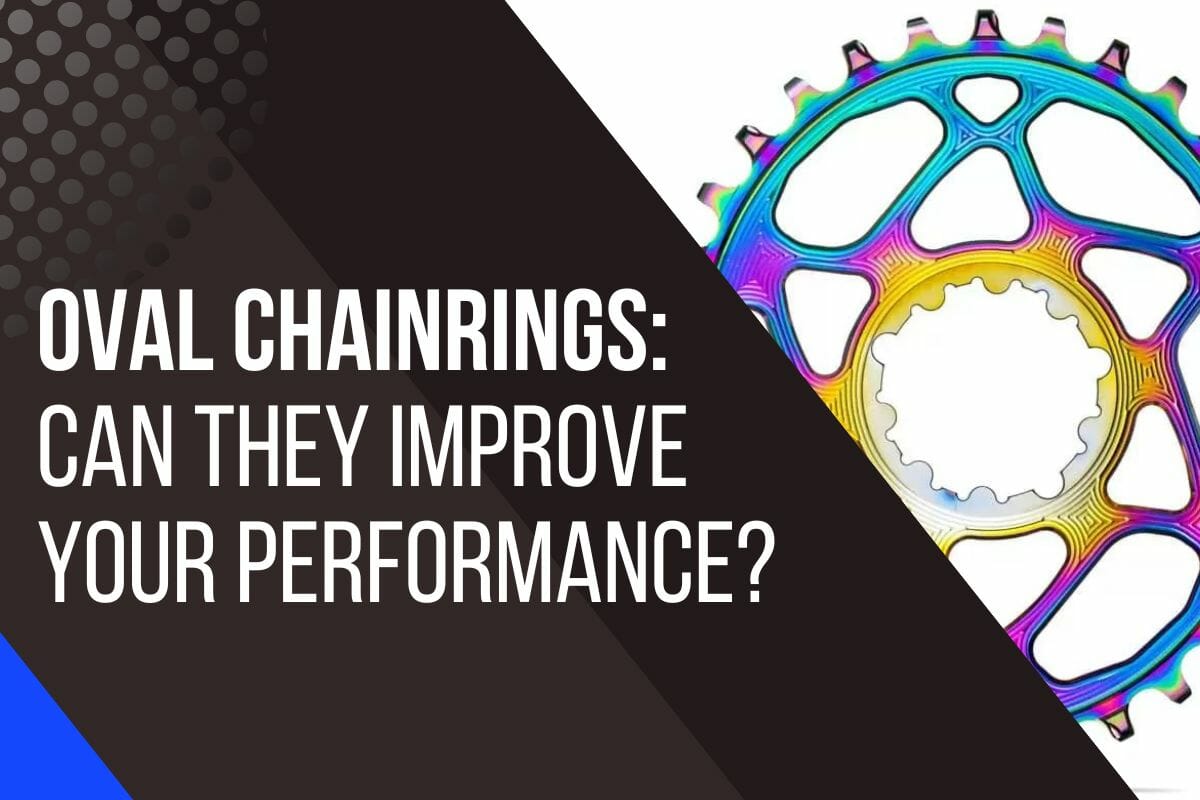Oval Chainrings: Can They Really Improve Your Cycling Performance?

Want to take your cycling game to the next level and say goodbye to leg fatigue?
Then it’s time to give oval chainrings a shot!
These unique-shaped wonders distribute force evenly throughout your pedal stroke, giving you more power on the downstroke and a seamless transition on the upstroke.
Below I’ll break down what oval chainrings are, how they work, and all the awesome benefits they bring.
I’ll also dish out my top recommendations for the absolute best oval chainring on the market.
What are Oval Chainrings?
Oval chainrings are non-circular-shaped chainrings that differ from the traditional round chainrings found on most bikes.
As the name suggests, their shape is mainly oval or elliptical. While they are not a new concept, their usage has gained popularity in recent years, especially among mountain bikers and gravel riders.
Oval chainrings are designed to be mounted on the cranks as the main front chainring. They can be used as a standalone ring for modern mountain bikes or as part of a set (2x oval chainrings) with a front derailleur.


The Mechanics of Oval Chainrings
Oval chainrings transform your biking experience by adjusting the gear ratio as you pedal.
Unlike regular circular chainrings, oval ones vary in shape, increasing and decreasing torque throughout each pedal stroke.
The oval shape reduces the resistance felt during the weakest part of the pedal stroke, or “dead spot,” and maximizes power during the strongest part of the pedal stroke.

By optimizing force output at different points in the stroke, you can maximize speed and climbing ability without constantly shifting gears.
This leads to a smoother and more efficient transfer of power, making your rides more enjoyable and easier to maintain consistent power output and cadence.
Pros & Cons: Should You Use Oval Chainrings?
Below, we’ll take a closer look at the pros and cons of using oval chainrings.
Pros
Cons
Pros
These specially designed chainrings offer several benefits, including improvements in power, torque, and traction, making them an attractive option for mountain bikers and those who enjoy technical riding.
1. Power and Torque Consistency
Oval chainrings are a game-changer for power and efficiency in cycling. With their unique shape, they greatly enhance the transfer of energy from your pedal stroke.
By generating more torque during the downstroke, they allow you to conquer steep climbs and tricky terrains which require immense power with ease.
2. Traction
They work wonders by ensuring a more consistent pedal stroke, eliminating that pesky dead spot where no power is delivered.
Say goodbye to slipping and losing traction, because oval chainrings help you maintain your speed.
If you are using oval chainrings on slippery terrain, there are a few things you can do to take advantage of their traction benefits.

Firstly, keep a steady pedaling speed without sudden changes in cadence.
This will keep you in control and enable you to conquer challenging climbs and descents.
Using lower gear ratios can also give you more force and torque, resulting in improved efficiency and traction on steep inclines or tricky terrains.
3. Efficiency & Ergonomics
Oval chainrings are a popular choice among cyclists due to their ergonomic benefits.
Unlike circular chainrings, the oval shape of these rings fits the natural biomechanics of human leg muscles, resulting in a smoother and more effective delivery of power during pedaling.
This reduction in disruption to the cadence and flow of pedaling leads to less strain on the knees and better activation of the glutes and hamstrings.
The improved activation of leg muscles at their natural strengths thanks to the oval shape means that cyclists can exert less stress on weak spots, such as their knees, and focus on generating power where their muscles are naturally stronger.
4. Adaptability

Oval chainrings offer an impressive level of adaptability and can be used on a wide range of bike styles.
With their various configurations, oval chainrings allow cyclists to customize their pedaling efficiency and torque output to match their individual needs.
Some of the different configurations offered by oval chainring models include tooth count adjustment and the position of the chainring bolts.
The Cons
1. Not Great at High RPMs
While oval chainrings offer improvements in power and torque, they can be less effective for high RPMs.
The shape of the oval chainring can make it more challenging to maintain high cadences, which can be problematic for riders who enjoy long-distance road riding.
Round chainrings feel much smoother at high RPMs because your legs don’t change speed as you pedal.
2. High Cost
When considering switching to oval chainrings, it’s important to carefully weigh the cost versus the potential benefits for your individual riding style and needs.
For example, some individuals who push hard while riding may find those oval chainrings are unable to deliver consistent power.

3. Not Suitable For Single-Speed Bikes
As a single-speed rider, one of the biggest hurdles you’ll face is maintaining the right chain tension. It can be a real pain in the neck.
But there’s a solution: an eccentric bottom bracket.
With this handy device, you can easily adjust your chain tension by rotating the bottom bracket. No more fiddling around with your chain and getting frustrated!
But that’s not the only problem you might encounter with an oval chainring on a single-speed bike. Chain drop is another potential issue that can cause a sudden loss of power and control.
Luckily, there are ways to prevent it. Chain guides and narrow-wide chainrings are both great options to keep your chain in place.
4. May Cause Knee Pain
There’s no concrete evidence indicating that oval chainrings are the culprits behind your discomfort. However, some riders have reported feeling pain in their knees.
Keep in mind that improper bike fit is also a frequent cause of knee pain. So before jumping to conclusions and blaming your oval chainring, make sure your bike is adjusted correctly to fit your body.
Things To Consider When Buying Oval Chainrings
Let’s dive into some of the key things you should consider before making your purchase, like the size of the teeth, whether it’s compatible with your drivetrain, and how easy it is to install.
I’ve also got some top-notch recommendations for you so you can find the perfect oval chainring for your ride and take your cycling game to the next level.
Tooth Size
Oval chainrings have a 2+ and 2 gearing configuration.
When you select a 30T oval chainring, you’ll receive a 28T and a 32T.
Oval chainrings are available in sizes 30T, 32T, and 34T for mountain bikers and up to 50T for road/gravel bikes.
Smaller rings produce lower gears, making them ideal for hilly or mountainous areas. Larger rings, on the other hand, produce higher gears, providing you with more power.
When selecting the tooth size, consider your riding style and terrain. If you are a mountain biker, you may want to opt for a smaller chainring size that will make it easier to climb steep hills.
If you are a road cyclist or gravel rider, you may want to go for a bigger chainring size that will allow you to gain more speed.
Drivetrain Groupset
Different manufacturers require a unique fit, which makes it crucial to choose an oval chainring that is compatible with the manufacturer of your groupset.
Some of the biggest drivetrain groupset makers include SRAM and Shimano, and it is essential for riders to ensure they select an oval chainring that matches their groupset.
Therefore, if you have a Shimano groupset, it is important to select an oval chainring that is specifically designed for Shimano groupsets.
Recommended Oval Chainrings
Below, we will discuss the best oval chainrings available in the market, highlighting their unique features, benefits, and compatibility with different drivetrain groupsets.
Absolute Black Oval Chainring


The Absolute Black Oval Chainring is a game-changing technology designed to optimize pedaling torque and reduce effort on climbs, leading to increased efficiency, power, and speed.
This results in smoother delivery of power that reduces the stress on the knees, reducing the likelihood of knee pain.
This precision-engineered chainring is compatible with a wide range of drivetrain groupsets, making it an excellent option for anyone looking to save energy on the road or trail.
I like their eye-catching colors, especially the rainbow and gold ones.
The Absolute Black Oval Chainring is an investment, with prices ranging from $100 depending on the model and size you select. While the price may seem high at first, the benefits are well worth the cost.
Wolf Tooth Oval Chainring
Unlike other oval chainrings designed for aggressive topography, this Wolf Tooth Oval chainring exhibits a less aggressive oval shape. This shape leads to a smoother ride and better traction, especially on slippery terrains.
With its unique design, this chainring requires less shifting, making your ride smoother and eliminating any uneven pedal stroke.
Wolf Tooth offers several tooth-size options. The size you choose will affect both your gear ratios and your power output.
Opting for smaller teeth will give you a lower gear ratio, providing easier pedaling on steep climbs. However, the power output will decrease.
Larger teeth, on the other hand, give you a higher gear ratio, improving your power output.
SRAM Eagle X-Sync 2 Oval Chainring
The SRAM Eagle X-Sync 2 Oval Chainring is a top-of-the-line product that offers several advantages to improve your cycling performance.
One of its most notable features is the tooth profile, which is specifically designed to enhance durability, reduce noise, and improve chain retention.
The oval shape of the chainring, combined with its unique tooth design, delivers a smoother delivery of power, helping you to conquer steep climbs and slippery terrain with more ease.
As a premium option, the SRAM Eagle X-Sync 2 Oval Chainring price ranges from $80 to $100+. While this may seem steep, the advanced technology and premium materials used in the manufacturing process justify the higher cost.
Installing Oval Chainring
Alignment with the center of crank is crucial to ensure optimal performance and comfort.
If you are installing an Absolute Black ring, there is a little dot that you should align with the center of crank arm. This dot represents the optimal position of the oval chainring.
Here are the key steps for installing an oval chainring:
Remove the Existing Chainring
Begin by removing the bolts that attach the current chainring to the crankset. Once the bolts have been removed, take the old chainring off the cranks and set it aside.
Align the Oval Chainring
Place the oval chainring on the cranks and remember to align the little dot on your Absolute Black chainring. Then, thread the bolts back into place but do not tighten them yet.
Reattach the Chain
Put the chain back on the chainring and line up the chain with the derailleur. Check that everything is aligned correctly and that the chain isn’t too tight or too loose.
Tighten the Bolts
Carefully tighten all the bolts, making sure that the chainring is properly aligned with the center of the cranks. Start by tightening the bolts in opposite pairs to ensure even pressure distribution.
Check for Chain Clearance
Double-check that the chainring isn’t obstructing the chain’s movement and that the chain doesn’t rub against the derailleur. If necessary, adjust the position of the chainring slightly until it clears the chain completely.
If you’re still struggling with the installation process, you can find helpful installation videos on the Absolute Black website or other cycling equipment retailers’ websites.
Do Oval Chainrings Make Any Differences?
Studies have shown that oval chainrings lead to a smoother delivery of power and a reduced oxygen consumption rate, resulting in an increase in pedal efficiency.
According to a scientific study, riders using oval chainrings at self-selected cadences showed a 15.7% increase in peak power output and a 1.5% reduction in oxygen consumption compared to circular chainrings. (1, 2)
A study on non-circular chainrings found that the maximal power output was significantly higher (+ 4.3%) compared to circular chainrings. (3)
Despite these benefits, circular chainrings are not entirely inferior as they provide a constant amount of resistance throughout the pedal stroke, allowing for consistent power delivery.
However, some experts argue that constant resistance limits the optimization of natural biomechanics, and slight improvements can reduce ankle joint stress and improve physiological responses.
My Verdict
As a passionate cyclist, I can personally vouch for the incredible benefits of using oval chainrings.
They have completely transformed my pedal stroke, making it feel more natural and effortless, even on challenging climbs.
Now, some may argue that oval chainrings are pricey, but trust me, the investment is absolutely worth it.
When it comes to top-performing brands, Absolute Black and SRAM XX1 are the true champions in the oval chainring market.
With Absolute Black, you’ll enjoy unparalleled performance, while SRAM XX1 provides an incredibly smooth pedal stroke for an unbeatable riding experience.
CTA: Ready to upgrade your cycling gear? Check out our essential list of mountain biking gear.





